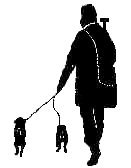
March 2004
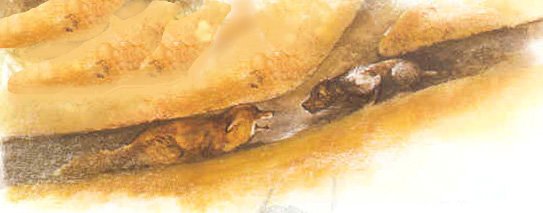
Introduction to Work
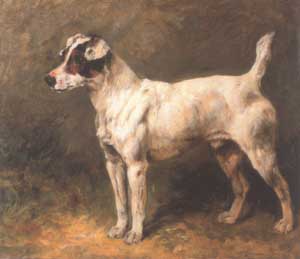 Introduction
Introduction
This web page is
designed as an aid to those interested in hunting their
terriers against American quarry. The most important
requirement of a working terrier is an owner that will
work it. Terrier
work is not complicated, but a lot can go wrong, some
real knowledge is needed, and relatively few dogs make
the grade in terms of size and temperament.
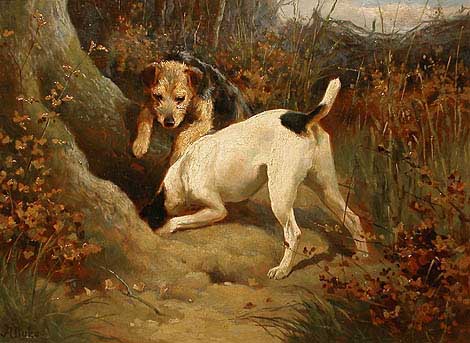 Mistakes
and Regrets
Mistakes
and RegretsIf you dig, you will make mistakes. If you are smart, you will learn from them. This list of 20 common problems is a litany of what to avoid, a caution about what to remember, and an etiquette guide for the new digger. >> To read more
A working terrier should be able to go straight through most of the den pipes it has to work. In America, that means a dog with a chest of 14 inches or less -- the same size as that of a red fox, adult groundhog, or average raccoon. An over-large dog will have difficulty negotiating curves and constrictions, is more likely to get trapped underground, and will find it harder to maneuver away from the slashing teeth of the quarry. A dog "bottled" by dirt behind and dirt or quarry in front, may have a difficult time getting enough air.
>> To read how to span a terrier
>> To see the average size of American working terriers
 Fox Are the Same All Over
Fox Are the Same All Over
Barry Jones, terrierman to the Cotswold Foxhounds, a former Chairman and President of the Fell and Moorland Working Terrier Club, and the founding Chairman of the National Working Terrier Federation writes: "I have not encountered a fox which could not be spanned at 14 inches circumference." >> To read more about fox size
Adult groundhogs and raccoons have the the
same chest size as red fox. If you have a terrier than
cannot make it through a large groundhog pipe, your dog
is too big. >> To read more about chest size of American quarry.
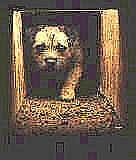 Giving Your Dog
Experience
Giving Your Dog
ExperienceYou cannot expect your dog to slide down a pipe and work quarry on its first time out. One way to give your dog a safe and fun learning experience and to hook up with people that work their dog is to participate in AWTA, AKC or JRTCA go-to-ground earthdog trials. While these are not close approximations of real hunting, they will give your dog some experience going into dark tunnels.
>> To read more
There is no better investment than a good shovel. An excellent shovel is the Ames "Pony" sold by A.M. Leonard and other industrial tool companies. This shovel is heavy, has a good dish, and holds an edge when sharpened. A trick of the trade is to drill a hole in the shoulder of the blade so you can attach a leash to the shovel and sling it over your back.
>> To read more about shovels and how to make a Bertha
>> To read more about carrying tools in the field
>> To read more about posthole diggers
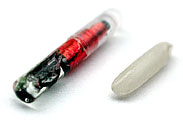 Microchipping, Tattoos and Slide
Tags
Microchipping, Tattoos and Slide
TagsWhen out hunting, we are often far from home, and our dogs are without their normal dangle tags. A compounding problem is that some dogs may go off on their own if they think it will provide a dividend. Microchipping, tattoos and slide tags are the answer. >> To read more
A Deben box is a radio receiver set to a special frequency, while a Deben collar is a small and very weak transmitter set to send a signal at that frequency. Simple triangulation, a dexterous finger, a little practice, and a touch of voodoo are all that is required to find your dog provided you have avoided two bad locations. >> To read more
Collars can go on the fritz while working in the field, especially if you are working creek bottoms, wet grassy fields, or the dog takes a swim in a pond. A well-taped collar is the best way to make sure your collar works even when in wet hole or in wet conditions. >> To read more
A simple pole snare is a very useful tool at the end of a dig and will save your dog a lot of abuse. Once a raccoon, groundhog or fox is bottled in a sette, the dog can be pulled and the quarry snared as it bolts. If your quarry is fox, you should purchase three or four nylon fox nets from the JRTCA. >> To read more
Along with a good shovel, you will need a 6' long 3/4" digging bar, a tie-out stake, a machete to cut through brambles, and a long-handled trowel. A posthole digger is useful, and a strong canvas pack to carry small tools such as a flashlight, root saw, eyewash and knife is required.
>> To read more
 Single-Handed Digging
Single-Handed DiggingIf you assemble your equipment right, you can hunt solo with a complete pack, a 6-foot bar, a heavy-duty shovel, and a posthole digger, while still keeping both hands free for dogs and hedgerow. The trick is nothing more than a good pack with shoulder rings, and a series of cheap cotton leashes you can assemble for less than $5 each.
>> Here's how
You should be prepared to administer first aid to your dog in the field, from washing out eyes to treating cuts and abrasions. You should know what to do if your dog is skunked underground, encounters a porcupine, or is caught in a trap. A small plastic tool box or tackle box makes an excellent health care kit. >> To read more
Most farms in the Eastern U.S and Midwest have groundhogs, and many farmers are anxious to get rid of them as they can girdle young orchard trees, damage haying equipment, wreck vegetable crops, weaken fences, and dig holes that can cripple a horse. Berry farms, vineyards, and anyone with stored hay are likely to have problems with raccoons and possums. Look for farms with corn, soy, alfalfa, water and thick hedgerows. A good tip is to contact a local agricultural services company.
Hedgerows along the edges of soy, corn and alfalfa fields are especially likely places for groundhogs. All quarry prefer to den in well-drained soil. Freshly moved dirt in December or January is a good sign of fox. Raccoon will follow seasonal food sources. >> To read more
Digging a hole is not quite as self-evident as it appears. Most groundhog, possum and raccoon are found about 3 to four feet down. Trench across the den pipe to within a foot of the dog, and then break through after you have located the pipe with a bar. Holes bigger than 3 feet require much larger excavations. >> To read more
Dispatch should be quick and sure. A sharp blow to the head with the back of a machete works very well. If it is not necessary to dispatch an animal, please consider releasing it. When digging hedgerow and forest settes, please rebuild the den pipes to encourage groundhog, raccoon, possum and fox to return. >> To read more
After a day in the field, be sure to wash out your dog's eyes with distilled water. Roll the eye lids back, top and bottom, and use a squirt bottle to wash out mud and dirt. Look over the dog, especially around the muzzle, for cuts or punctures, and check the dog for ticks as well. Repeat when you get home, and also administer a flea bath to kill off any mange mites.
Here's a quiz that's only 10 questions long, but covers a lot of ground. What does it means when the Deben box is on the fritz? What do you do when your dog disappears underground in an undiggable earth? What is the most essential characteristic of a working terrier? What is the true chest span of a red fox? What is the average height of American fox-working terriers? Can you tell one bit of animal scat from another? What's the world's foremost authority on red fox say about foxes and fox hunting? >> To take the quiz